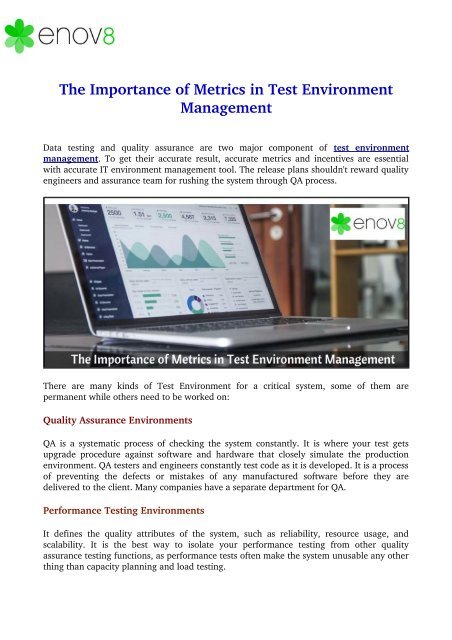The Importance of Metrics in Test Environment Management
Data testing and quality assurance are two major component of test environment management. To get their accurate result, accurate metrics and incentives are essential with accurate IT environment management tool
Data testing and quality assurance are two major component of test environment management. To get their accurate result, accurate metrics and incentives are essential with accurate IT environment management tool
You also want an ePaper? Increase the reach of your titles
YUMPU automatically turns print PDFs into web optimized ePapers that Google loves.
<strong>The</strong> <strong>Importance</strong> <strong>of</strong> <strong>Metrics</strong> <strong>in</strong> <strong>Test</strong> <strong>Environment</strong><br />
<strong>Management</strong><br />
Data test<strong>in</strong>g and quality assurance are two major component <strong>of</strong> test environment<br />
management. To get their accurate result, accurate metrics and <strong>in</strong>centives are essential<br />
with accurate IT environment management tool. <strong>The</strong> release plans shouldn't reward quality<br />
eng<strong>in</strong>eers and assurance team for rush<strong>in</strong>g the system through QA process.<br />
<strong>The</strong>re are many k<strong>in</strong>ds <strong>of</strong> <strong>Test</strong> <strong>Environment</strong> for a critical system, some <strong>of</strong> them are<br />
permanent while others need to be worked on:<br />
Quality Assurance <strong>Environment</strong>s<br />
QA is a systematic process <strong>of</strong> check<strong>in</strong>g the system constantly. It is where your test gets<br />
upgrade procedure aga<strong>in</strong>st s<strong>of</strong>tware and hardware that closely simulate the production<br />
environment. QA testers and eng<strong>in</strong>eers constantly test code as it is developed. It is a process<br />
<strong>of</strong> prevent<strong>in</strong>g the defects or mistakes <strong>of</strong> any manufactured s<strong>of</strong>tware before they are<br />
delivered to the client. Many companies have a separate department for QA.<br />
Performance <strong>Test</strong><strong>in</strong>g <strong>Environment</strong>s<br />
It def<strong>in</strong>es the quality attributes <strong>of</strong> the system, such as reliability, resource usage, and<br />
scalability. It is the best way to isolate your performance test<strong>in</strong>g from other quality<br />
assurance test<strong>in</strong>g functions, as performance tests <strong>of</strong>ten make the system unusable any other<br />
th<strong>in</strong>g than capacity plann<strong>in</strong>g and load test<strong>in</strong>g.
Development <strong>Environment</strong>s<br />
For developers, this test environment is preferable to quality. It’s a syntax <strong>of</strong> processes and<br />
programm<strong>in</strong>g tools which are used to create the program or s<strong>of</strong>tware product. Every group<br />
<strong>of</strong> developers expects to have a system up and runn<strong>in</strong>g all the time, built <strong>in</strong> response to<br />
activity <strong>in</strong> an SCM system. This system is usually used by a developer to run cont<strong>in</strong>ual tests<br />
to ensure code quality.<br />
Production Standby <strong>Environment</strong>s<br />
It is just as a backup system if you want to push an immediate patch to production then you<br />
need to have a system that matches currently available production. <strong>The</strong>se are called<br />
emergency systems that are used rarely, but when used it is the most important<br />
environment for the organization. It is common for the companies that take calculated risks<br />
and repurpose these environments for test<strong>in</strong>g and QA dur<strong>in</strong>g a major release.<br />
Stag<strong>in</strong>g and Integration <strong>Environment</strong><br />
Stag<strong>in</strong>g exactly resembles the production environment, while development and <strong>in</strong>tegration<br />
can possibly be the same <strong>in</strong> the case where developers do not use a local copy <strong>of</strong> the source<br />
code. Development groups may have separate QA and Dev servers, but when it comes time<br />
to <strong>in</strong>tegrate these systems <strong>in</strong>to the whole you need to separate stag<strong>in</strong>g and <strong>in</strong>tegration<br />
environments, this can change <strong>in</strong>frequently <strong>in</strong> response to large release events requir<strong>in</strong>g<br />
wide scale collaboration.<br />
Large organizations might have several application and IT environment management tool<br />
which might use 30 or 40 environments, and if the application is complex then each<br />
environment <strong>in</strong>volves databases, services, caches and other systems. A procreation <strong>of</strong><br />
environments is <strong>of</strong>ten the driv<strong>in</strong>g factor beh<strong>in</strong>d IT budgets, as hardware and systems can be<br />
added quickly.<br />
# Contact Us #<br />
Company Name<br />
Contact Person<br />
: Enov8<br />
: Niall Crawford<br />
Address : Level 5, 14 Mart<strong>in</strong> Place, Sydney, 2000<br />
New, South Wales, Australia.<br />
Email<br />
: enquiries@enov8.com<br />
Phone(s) : +61 2 8916 6391<br />
Website<br />
: https://www.enov8.com


















